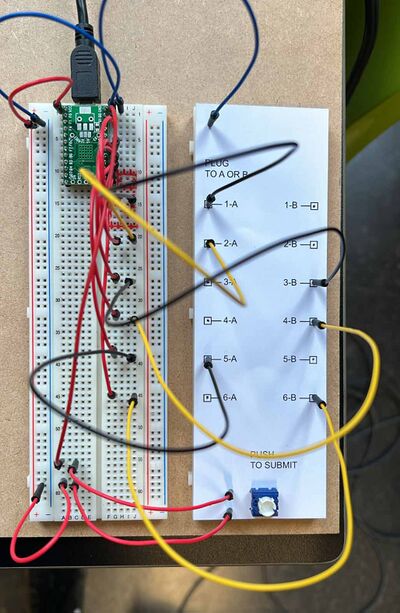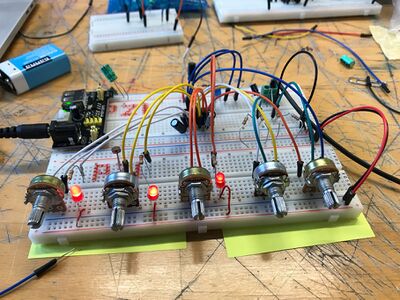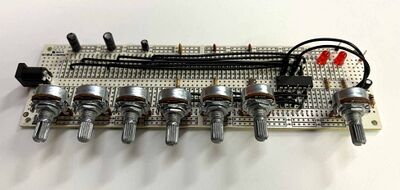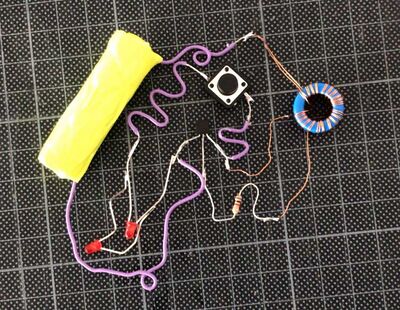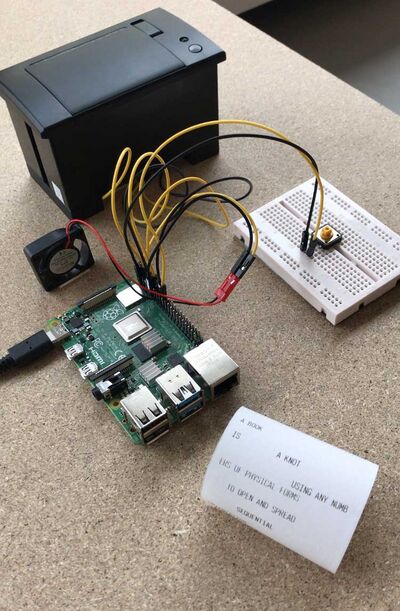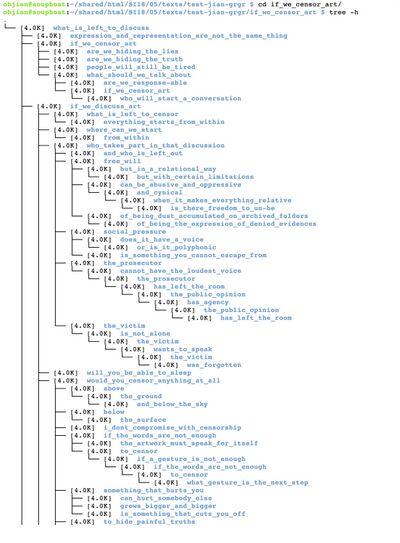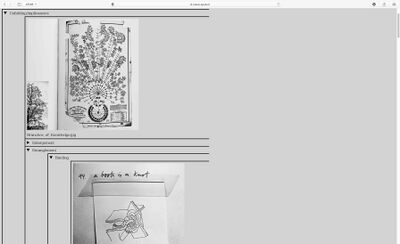User:Ohjian/Project-Proposal
Project Proposal
What do you want to make?
For my Graduation Project I want to use the well-known concept of Modular Synthesis. Instead of working with sound, I want to translate the idea to the realm of print publishing. More precisely, I want to create physical modules that perform operations on text and images to create printed outcome.
Modular Synthesis
A modular synthesizer is an electronic instrument that generates electronic sounds. It consists of many different and independent modules that can be combined in any numbers of ways to create and manipulate the output. Each module performs a certain operation which can be controlled by adjustable components like switches, sliders and patch cables. The output of one module can be used as the input for another module. This allows for creative combinations, loops and unexpected outcome.
For my project I understand a module as a small unit that provides a specific operation as well as an operation-specific physical interface.
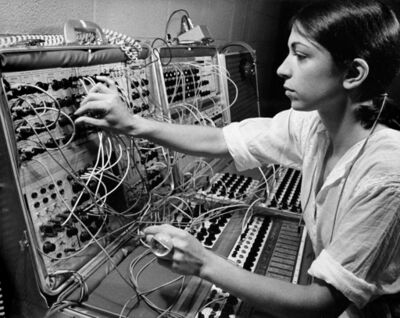
(Suzanne Channi and the Serge Modular Synthesizer)
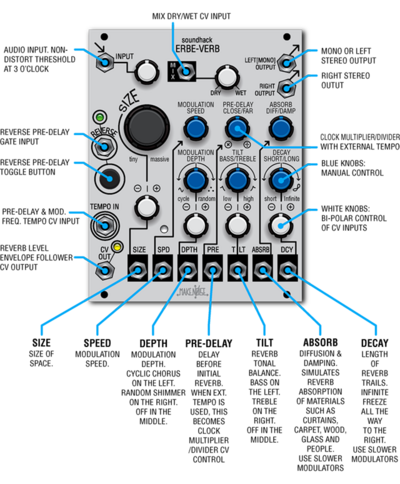
(Erbe Verb by Make Noise, Illustrated Manual)
Desktop Publishing (DTP)
The Technology of Desktop Publishing is commonly used to create printed matter and combines several hardware and software components:
- Input devices like keyboard, camera or scanner to generate text and images
- A personal computer with a Graphical User Interface (GUI) and WYSIWYG (what you see is what you get) layout software to manipulate text and images
- Control devices such as mouse, trackpad and keyboard for human-computer-interaction
- A printer that produces typographical and pictorial outcome
How do you plan to make it?
Re-thinking the components of Desktop Publishing with the concept of Modular Synthesis:
- Input modules: keyboard, camera or scanner to generate text and images
- Transform modules: devices that perform a specific operation on text or image and work as small, independent and combinable units with operation-specific physical interfaces
- Preview module: screen to have accurate representation of the process
- Output module: printer for typographical and pictorial outcome
Example: Weave text
[Bild]
General Approach
Once the overall technical infrastructure is formed, the concept of modularity allows for a step-by-step approach. This could mean to start with very few modules and to focus on text only. The modular structure implies an open-endedness and could keep growing even after the graduation.
Open Questions
- What is the right balance between analog and digital elements and processes?
- How to create a modular system that works for both text and images?
- How do the modules connect and communicate?
- How to represent all operations in operation-specific, physical interfaces to challenge new ways of interaction with the tools?
- What is the right balance between generating (e.g. typing a text), processing (e.g. weaving a text) and styling (e.g. defining the font for the text)?
What is your timetable?
September / October
17 Oct: Public Moment I (Leeszaal)
31 Oct: M&M, Monday Morning Sessions
- Research: reading and experimenting
- Draft for project proposal
November / December
5 & 6 Nov: Public Moment II (Zine Camp)
28 Nov: Public Moment III (Het Bollenpandje)
12 Dec: Assessments
- Research: reading and experimenting
- Final project proposal
- Draft for thesis outline
- Drafts and scenarios for the technical infrastructure
- First prototypes
January / February / March
17 Feb: Deadline first thesis draft
17 Mar: Deadline second thesis draft
- Research: experiments and prototypes
- Decisions for the technical infrastructure
- Modules: planning, designing and building
- Sessions to test the modules
- Thesis: reading and writing
- Documentation of the process
April / June
14 April: Final thesis deadline
- Modules: building and connecting
- Sessions to test the modules
- Documentation of the process
- Preparations for the Graduation Show
Why do you want to make it?
As a trained graphic designer, mainly concerned with printed matter and book making, I have been familiar with Desktop Publishing for more than ten years. The big player Adobe has been very present in all my making, designing and publishing processes and I never really reflected on the influence it might have on my practice. XPUB introduced me to the idea and benefits of alternative tools and software and I started to look at Desktop Publishing software from a more critical angle.
Parallel to that I was introduced to physical computing and started to experiment with microcontrollers and analog electronic circuits. I became interested in modular synthesizers and started to build a few small prototypes. Even though sound has never been part of my creative making practice, I was clearly fascinated by the concept behind it.
In my graduation project I want to bring together these two interest by using the concept of Modular Synthesis and translating it to the context of print publishing. By creating my own modules I want to suggest alternative physical interfaces and create a different experience of human-machine-interaction.
As creatives we are so used to seemingly flawless devices that experimental or clunky modules may help to slow down the process and produce unexpected outcome. This new perspective could help to reveal, reflect and evaluate what is normally concealed:
- How (and to what extent) tools shape our practice.
- What impact tools have on our imagination and independence as creatives.
- How our practice changes when we create our own tools.
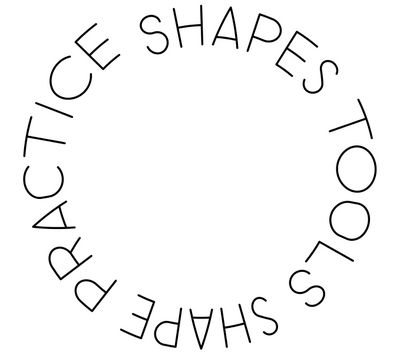
“The tools we use shape our practices. The practices we have shape our tools.”
(Open Source Publishing)
Who can help you and how?
Technical concept, realization and implementation
- Joseph Knierzinger, Manetta Berends and Michael Murtaugh
- Kamo and Erica (XPUB 2), Stephen (XPUB 1)
- WDKA Interaction station
Concept, context and relevance
- Joseph Knierzinger, Manetta Berends and Marloes de Valk
- Femke Snelting, Open Source Publishing
- Brendan Howell
- Hackers & Designers
Inspiration, documentation, license
- All projects mentioned in this proposal
- Supi and Kamo (XPUB 2)
- Aymeric Mansoux
Relation to previous practice
Workshop: The Screenless Office
In a workshop Brendan Howell introduced his project The Screenless Office. Collectively we developed a new function that was added to his Office: An operation that would use two texts as inputs, weave them together following a specific pattern and send it to the printer. Supi and I built a (screenless) physical interface with which the user could customize the pattern for the weaving function. We decided to use patchable cables as a physical representation of the weaving operation.
Analog Sound Synthesizers
A) Simple setup on a breadboard
- 1 fixed oscillator
- 2 variable oscillators (potentiometer)
- 1 variable oscillator (potentiometer + photocell)
- 2 mixers, each mixing two of the oscillators
- 1 oscilloscope (Arduino + LCD display)
B) Patchable / modular setup on a permanent breadboard
- 5 variable oscillators (potentiometer)
- 1 variable oscillator (potentiometer + photocell)
- 1 mixer, mixing two selected oscillators (patch cables to select)
Free Circuits
Book Generator
Nested Narratives (Special Issue 18, week 5)
Unfolding Implicancies (Special Issue 18, week 7)
Relation to a larger context
Brendan Howell: The Screenless Office
XPUB: SPECIAL ISSUE X: INPUT/ OUTPUT – Tales from another module
Sarah Garcin: PJ Machine
Femke Snelting, Christoph Haag: Conversations
Joseph Knierzinger: The Gesturewriter
Hackers & Designer: Counter Interfaces
Hackers & Designer: The Momentary Zine
References / Bibliography
-

